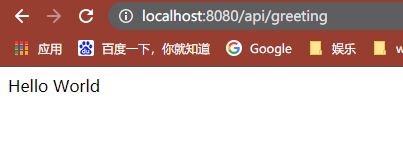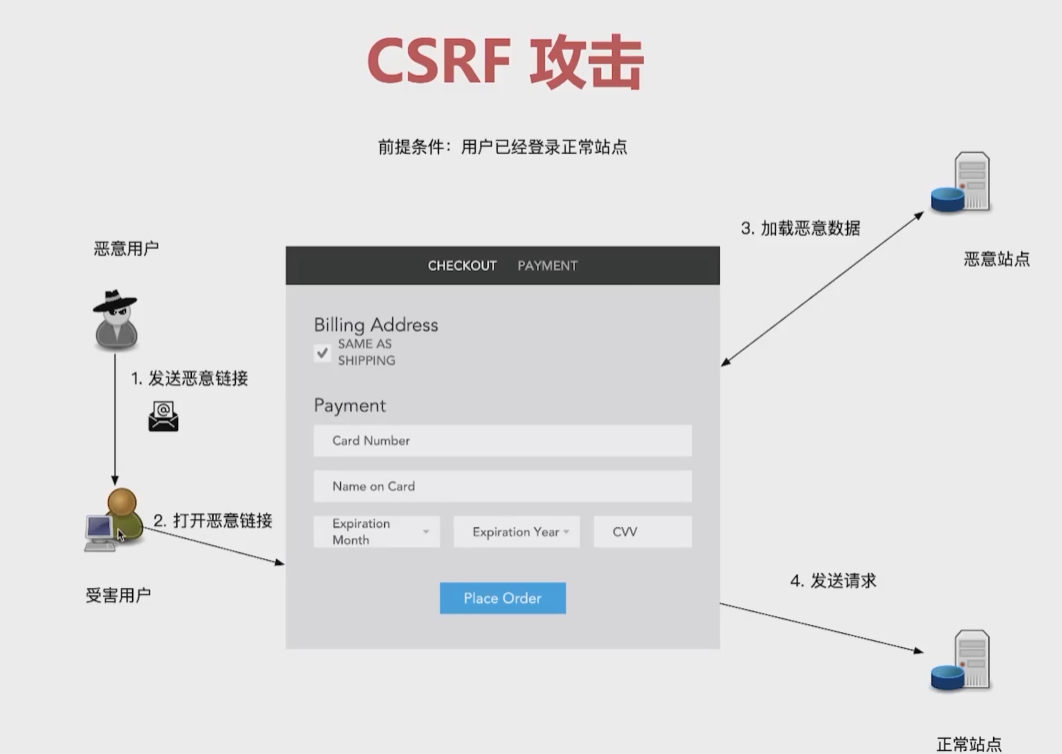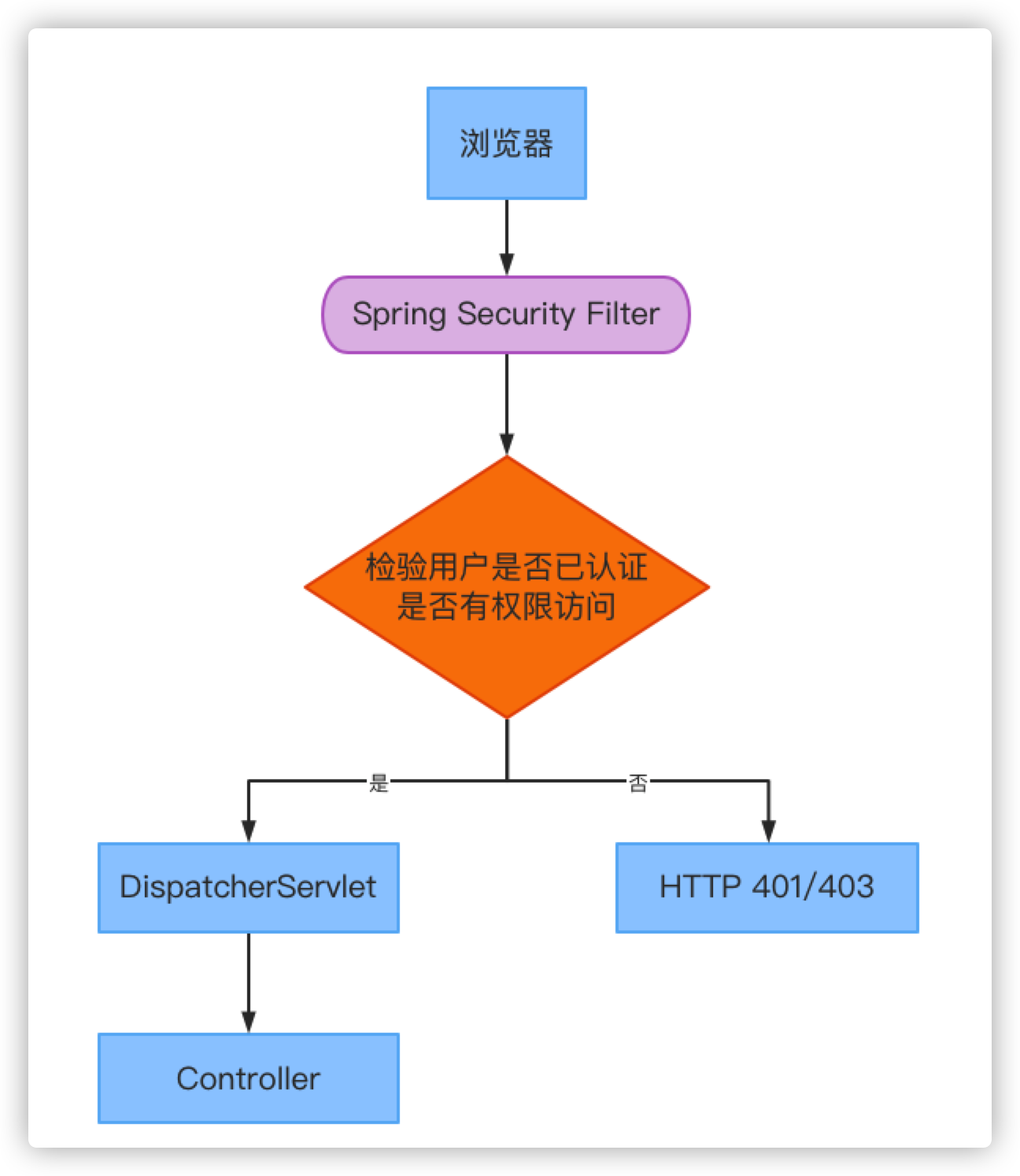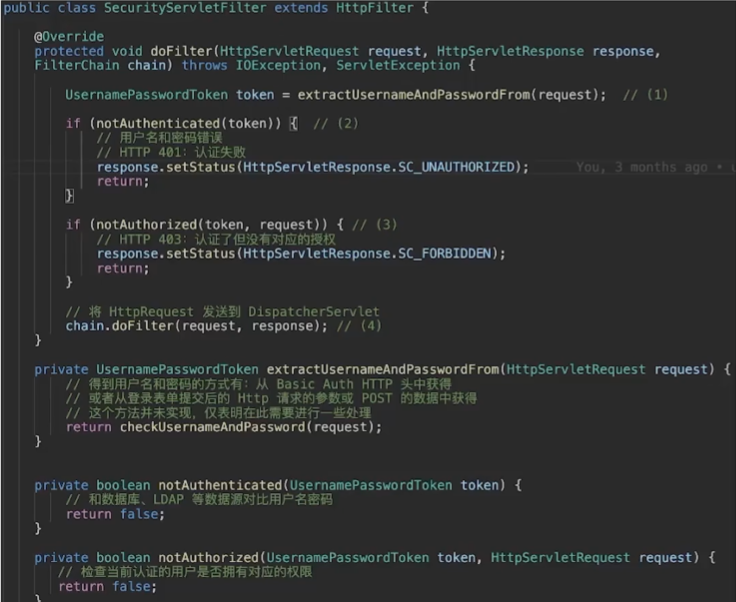SpringSecurity系列学习(一):初识SpringSecurity
系列导航
SpringSecurity系列
- SpringSecurity系列学习(一):初识SpringSecurity
- SpringSecurity系列学习(二):密码验证
- SpringSecurity系列学习(三):认证流程和源码解析
- SpringSecurity系列学习(四):基于JWT的认证
- SpringSecurity系列学习(四-番外):多因子验证和TOTP
- SpringSecurity系列学习(五):授权流程和源码分析
- SpringSecurity系列学习(六):基于RBAC的授权
SpringSecurityOauth2系列
- SpringSecurityOauth2系列学习(一):初认Oauth2
- SpringSecurityOauth2系列学习(二):授权服务
- SpringSecurityOauth2系列学习(三):资源服务
- SpringSecurityOauth2系列学习(四):自定义登陆登出接口
- SpringSecurityOauth2系列学习(五):授权服务自定义异常处理
SpringSecurity
Spring Security是spring采用AOP思想,基于servlet过滤器实现的安全框架。它提供了完善的认证机制和方法级的
授权功能。是一款非常优秀的权限管理框架。
学习SpringSecurity,一般都是从前后端不分离架构开始学习,然后学习前后端分离的JWT + SpringSecurity架构,之后再学习SpringSecurity + Oauth2微服务架构。
现在大部分项目都是前后端分离的,为什么还需要去看前后端不分离架构下SpringSecurity的一些东西呢?其实这部分的学习只是为了打一个基础,SpringSecurity的发展也是从前后端不分离开始的,不论是后来的前后端分离架构还是微服务架构,SpringSecurity的主要逻辑都是大同小异的。
当然这部分的学习我们先不进行编码,主要是去看概念和源码,因为在做项目的时候,主要还是采用的前后端分离的JWT + SpringSecurity架构或者SpringSecurity + Oauth2微服务架构,编码我们从第二章开始,这一章我们先看看SpringSecurity中的一些基础的东西。
认证和授权
说到SpringSecurity就要说到它的核心功能:认证和授权
认证:我是谁的问题,也就是我们通常说的登陆

授权:身份验证,我能干什么。

认证和授权在SpringSecurity中是怎么样的流程呢?
这里我们写一个简单的demo,来看一下在SpringSecurity中认证和授权的流程
认证Demo
新建一个springboot工程,引入依赖
<dependency>
<groupId>org.springframework.boot</groupId>
<artifactId>spring-boot-starter-security</artifactId>
</dependency>
引入依赖之后,SpringSecurity就已经有默认的配置了,这个时候写一个简单的控制器访问,会被SpringSecurity保护拦截。
/**
* @author 硝酸铜
* @date 2021/6/2
*/
@RestController
@RequestMapping(value = "/api")
public class UserResource {
@GetMapping(value = "/greeting")
public String greeting(){
return "Hello World";
}
}
启动项目,访问http://localhost:8080/greeting,会被SpringSecurity拦截,重定向到http://localhost:8080/login进行登录,这个页面是SpringSecurity默认的登陆页面

默认的用户名是:user,密码会在控制台输出出来:

登录之后,正常进行业务:

如果我们不使用网页去调用接口,而是使用postman这类工具去调用接口该怎么进行认证呢?
默认情况下,SpringSecurity会接受请求头中的Authorization的值去进行认证,以Basic 开头,后接账号密码,比如在请求接口的时候,添加请求头Authorization:Basic user a76dbd63-65d2-4cff-aebc-cc5dc4a6973d
这样就不会被重定向到登陆页面,而是直接通过认证。
授权demo
SpringSecurity默认配置下,所有接口只要认证通过即可访问,如果我们需要对一个接口进行限制,必须有哪一种权限才能访问,则需要进行安全配置
/**
* @author 硝酸铜
* @date 2021/6/2
*/
@EnableWebSecurity
public class SecurityConfig extends WebSecurityConfigurerAdapter {
@Override
protected void configure(HttpSecurity http) throws Exception {
http.authorizeRequests(req -> req.mvcMatchers("/api/greeting").hasAnyRole("ADMIN"));
}
}
具体为什么这么写我们先不讨论,这里的意思就是访问/api/greeing这个路径需要有ADMIN这个角色,重新启动项目,访问该路径:

403禁止访问,未授权,没有该权限
我们现在给用户授权:
@Override
protected void configure(HttpSecurity http) throws Exception {
http
.formLogin(Customizer.withDefaults())
///api/greeting 路径需要检查认证信息
.authorizeRequests(req -> req.mvcMatchers("/api/greeting").authenticated());
}
这里的意思是,我们不再检查权限,只检查该认证信息,重新启动,访问该路径:

这就是在SpringSecurity中的认证和授权的过程,其中的具体逻辑和源码,我们在后面进行详细学习,现在小伙伴们先了解个大概
安全配置
一开始我们引入SS的时候,会生成默认的配置,比如默认的表单登录页面,HTTP BASIC认证等等,其本质就是WebSecurityConfigurerAdapter这个基类带来的配置
public abstract class WebSecurityConfigurerAdapter implements WebSecurityConfigurer<WebSecurity> {
...
protected void configure(HttpSecurity http) throws Exception {
this.logger.debug("Using default configure(HttpSecurity). If subclassed this will potentially override subclass configure(HttpSecurity).");
http.authorizeRequests((requests) -> {
// 所有的接口都需要通过认证
((AuthorizedUrl)requests.anyRequest()).authenticated();
});
// 默认的表单登陆页面
http.formLogin();
// 使用HTTP BASIC认证,也就是请求头中的Authorization:Basic username passowrd
http.httpBasic();
}
...
}
这个默认的方法分为三个部分:
- 配置认证请求
- 配置表单
- 配置HttpBasic
这三个部分可以通过and()来连接,and()返回一个HttpSecurity,形成链式写法。
如果用函数式写法(推荐),直接就能使用链式写法。
如果我们需要自定义安全配置,则需要继承WebSecurityConfigurerAdapter这个基类,重写configure方法。
import org.springframework.security.config.Customizer;
import org.springframework.security.config.annotation.web.builders.HttpSecurity;
import org.springframework.security.config.annotation.web.configuration.EnableWebSecurity;
import org.springframework.security.config.annotation.web.configuration.WebSecurityConfigurerAdapter;
import org.springframework.security.config.annotation.web.configurers.AbstractHttpConfigurer;
/**
* `@EnableWebSecurity` 注解 deug参数为true时,开启调试模式,会有更多的debug输出,不要用在生产环境
* @author 硝酸铜
* @date 2021/6/2
*/
@EnableWebSecurity(debug = true)
public class SecurityConfig extends WebSecurityConfigurerAdapter {
@Override
protected void configure(HttpSecurity http) throws Exception {
http
//取消CSRF保护
.csrf(AbstractHttpConfigurer::disable)
//默认的HTTP Basic Auth认证
.httpBasic(Customizer.withDefaults())
//默认的表单登录
//.formLogin(Customizer.withDefaults())
//关闭表单登录
.formLogin(AbstractHttpConfigurer::disable)
//对 /api 路径下的所有接口进行验证,需要权限`ROLE_USER`
.authorizeRequests(req -> req.antMatchers("/api/**").hasAnyRole("USER"));
}
@Override
public void configure(WebSecurity web) {
web
.ignoring()
.antMatchers("/error",
"/resources/**",
"/static/**",
"/public/**",
"/h2-console/**",
"/swagger-ui.html",
"/swagger-ui/**",
"/v3/api-docs/**",
"/v2/api-docs/**",
"/doc.html",
"/swagger-resources/**")
.requestMatchers(PathRequest.toStaticResources().atCommonLocations());
}
}
重写configure(HttpSecurity http)让我们可以配置认证和授权,也就是说走到这个方法的时候,是经过了过滤器链的。
启动过滤器链是很昂贵的,占用了系统很多资源,有时候我们经过一个路径(比如访问静态资源:图片,视频等),不需要进行认证和授权,也就不需要启动过滤器链,为了节约系统资源,可以通过重写configure(WebSecurity web)方法来禁用过滤器链
一些前后端不分离的安全配置概念(了解即可)
CSRF攻击
CSRF攻击对于无状态应用(前后端分离,使用token,天然免疫)来说是无效的,只有Session类应用需要去预防
当进行登录的时候,如果没有禁用CSRF配置,那么每个POST请求必须携带一个CSRF Token,否则不予授权
为什么会有这样一个配置呢,这首先要从CSRF攻击说起
这种攻击的前提条件是:用户已经登录正常站点
很多网站的登录状态都是一个有时间周期的Session,这种攻击就是利用这一点。
当一个受害用户已经正常的登录过一个站点,并且这个登录的Session还在有效期内时,一个恶意用户发起一个链接给受害用户,比如发起一个银行账户变更通知的链接,然后受害用户登录点击进去,那个恶意页面也和正常的银行页面长得非常像。
这个恶意页面要求受害用户输入他的银行账户,密码,姓名等敏感信息。等受害用户输入之后,这个恶意页面就将这些信息发送给网银,由于受害用户已经登录过网银,并且其Session还没有过期,这些恶意页面发送的数据就等于是在受害用户许可之下发送的,受害用户的网银就被轻松攻破了。

防止受到CSRF攻击的方式
第一种:CSRF Token
由服务器生成,并设置到浏览器Cookie当中,前端每次都会从cookie中将这个token读取出来,服务端要求每个请求都需要带上这个token。提交到服务端之后,服务端会比较CSRF Token,看他是不是和服务端保存在Session中的token一致。这个token每个请求都是不一样的
第二种:在响应当中设置Cookie的SameSite属性
private AuthenticationSuccessHandler jsonLoginSuccessHandler(){
return (req,res,auth) ->{
//..
Collection<String > headers = res.getHeaders(HttpHeaders.SET_COOKIE);
res.addHeader(HttpHeaders.SET_COOKIE,String.format("%s; %s",header,"SameSite=Strict"));
};
}
即在响应当中的Cookie当中设置SameSite属性
但是这个对于浏览器兼容性来说不友好,ie不支持。
所以现在主流还是CSRF Token方法
设置CSRF
http.csrf(csrf -> {
//保存策略,可以保存在在session(HttpSessionCsrfTokenRepository)或者cookie(CookieCsrfTokenRepository)中
csrf.csrfTokenRepository()
//忽略哪些路径
.ignoringRequestMatchers()
//哪些需要保护
.requireCsrfProtectionMatcher();
})
Remember me 功能
基于Session的功能:Session过期后,用户不需要登录就能直接访问
SpringSecurity提供开箱即用的配置rememberMe
原理:使用Cookie存储用户名,过期时间,以及一个Hash,Hash:md5(用户名+过期时间+密码+key)
当用户访问的时候,会判断Session有没有过期,如果过期了,就直接导到登录页。
如果没有过期,服务端就根据用户名,从数据库里面查到的用户名,密码,过期时间,key,进行md5加密,然后与客户端提交的md5进行对比,如果一致,则认证成功。
注意:md5加密中有密码,也就是说如果用户修改了密码,则需要重新登录。
http.rememberMe(rememberMe -> {
//存储策略,
rememberMe.tokenRepository()
//设置Cookie名称
.rememberMeCookieName()
//有效期设置,单位s
.tokenValiditySeconds()
//设置用户查询服务,实现UserDetailsService接口的类,提供根据用户名查询用户的方法
.userDetailsService()
//是否用安全的Cookie
.useSecureCookie();
})
退出
前后端不分离的退出设置
http
.logout(logout -> {
//退出登录的url
logout.logoutUrl()
//退出登录成功,重定向的url
.logoutSuccessUrl()
//设置LogoutHandler,自定义退出登录逻辑
.addLogoutHandler()
//删除Cookies
.deleteCookies()
//取消Session
.invalidateHttpSession()
//清理认证
.clearAuthentication();
})
前后端分离的登陆和退出采用增加过滤器或者接口的方式,不需要使用这个配置
Spring Security过滤器链
过滤器
其实任何的Spring Web程序,在本质上都是一个Servlet程序
Spring Security Filter在HTTP请求到达你的Controller之前,过滤每一个传入的HTTP请求

- 首先,过滤器需要从请求中提取一个用户名/密码。它可以通过一个基本的HTTP头,或者表单字段,或者
cookie等等。 - 然后,过滤器需要对用户名/密码组合进行验证比如数据库。
- 在验证成功后,过滤器需要检查用户是否被授权访问请求的URI。
- 如果请求通过了所有这些检查,那么过滤器就可以让请求通过你的
DispatcherServlet后重定向到@Controllers或者@RestController。

要使Spring Security生效,从可行性上来说,我们需要有一个Spring Security的Filter能够被Servlet容器(比如Tomcat、Undertow等)感知到,这个Filter便是DelegatingFilterProxy,该Filter并不受Spring IoC容器的管理,也不是Spring Security引入的,而是Spring Framework中的一个通用的Filter。在Servlet容器眼中,DelegatingFilterProxy只是一个Filter而已,跟其他的Servlet Filter没什么却别。
虽然DelegatingFilterProxy本身不在IoC容器中,它却能够访问到IoC容器中的其他对象(通过WebApplicationContextUtils.getWebApplicationContext可以获取到IoC容器,进而操作容器中的Bean),这些对象才是真正完成Spring Security逻辑的对象。这些对象中的部分对象本身也实现了javax.servlet.Filter接口,但是他们并不能被Servlet容器感知到,比如UsernamePasswordAuthenticationFilter。
过滤器链
通过这个过滤器示例,可以了解到通过过滤器完成认证和授权的基本过程。
在SpringSecurity中,这一过程不是通过一个过滤器来完成的,而是一系列的过滤器,也就是一个过滤器链,认证有认证的过滤器,授权有授权的过滤器,除此之外还有更多的,不同功能的过滤器

这种过滤器链的好处:
- 每个过滤器的职责单一
- 链式处理是一种比较好的方式,由简单的逻辑构成复杂的逻辑
当一个项目启动的时候,其Spring Security的日志输出:
2021-09-18 14:10:50.935 INFO 8265 --- [ main] o.s.s.web.DefaultSecurityFilterChain : Will secure any request with [org.springframework.security.web.context.request.async.WebAsyncManagerIntegrationFilter@56da7487, org.springframework.security.web.context.SecurityContextPersistenceFilter@6f94a5a5, org.springframework.security.web.header.HeaderWriterFilter@7ceb4478, org.springframework.security.web.authentication.logout.LogoutFilter@7cbeac65, org.springframework.security.web.savedrequest.RequestCacheAwareFilter@a451491, org.springframework.security.web.servletapi.SecurityContextHolderAwareRequestFilter@a92be4f, org.springframework.security.web.authentication.AnonymousAuthenticationFilter@10f7c76, org.springframework.security.web.session.SessionManagementFilter@25ad4f71, org.springframework.security.web.access.ExceptionTranslationFilter@77bbadc, org.springframework.security.web.access.intercept.FilterSecurityInterceptor@2b680207]
这就是Spring Security的过滤器链
重新访问/api/greeing这个路径,我们来看看日志:
2021-09-18 14:10:54.545 DEBUG 8004 --- [nio-8080-exec-1] FilterSecurityInterceptor : Failed to authorize filter invocation [GET /api/greeting] with attributes [authenticated]
2021-09-18 14:10:54.545 DEBUG 8004 --- [nio-8080-exec-1] HttpSessionRequestCache : Saved request http://localhost:8080/api/greeting to session
2021-09-18 14:10:54.545 DEBUG 8004 --- [nio-8080-exec-1] DefaultRedirectStrategy : Redirecting to http://localhost:8080/login
认证失败,重定向到了login
登录之后:
2021-09-18 14:11:03.247 DEBUG 8004 --- [nio-8080-exec-6] DaoAuthenticationProvider : Authenticated user
... ...
2021-09-18 14:11:03.247 DEBUG 8004 --- [nio-8080-exec-6] DefaultRedirectStrategy : Redirecting to http://localhost:8080/api/greeting
... ...
2021-09-18 14:11:03.247 DEBUG 8004 --- [nio-8080-exec-9] FilterSecurityInterceptor : Authorized filter invocation [GET /api/greeting] with attributes [authenticated]
2021-09-18 14:11:03.247 DEBUG 8004 --- [nio-8080-exec-9] FilterChainProxy : Secured GET /api/greeting
常见的内建过滤器链
SpringSecurity过滤器很多,并且还可以自己添加过滤器,如何添加过滤器我们之后在分析认证流程源码的时候会介绍。
不需要将每个SpringSecurity过滤器都搞明白,只需要知道一些常见的过滤器的作用就行了
org.springframework.security.web.authentication.www.BasicAuthenticationFilter此过滤器会自动解析HTTP请求中头部名字为Authentication,且以Basic开头的头信息。
org.springframework.security.web.authentication.UsernamePasswordAuthenticationFilter认证操作全靠这个过滤器,默认匹配URL为
/login且必须为POST请求。之后我们自定义认证流程其实也是通过重写这个过滤器实现。
org.springframework.security.web.authentication.AnonymousAuthenticationFilter当
SecurityContextHolder中认证信息为空,则会创建一个匿名用户存入到SecurityContextHolder中。SecurityContextHolder是什么在下一章解释spring security为了兼容未登录的访问,也走了一套认证流程,只不过是一个匿名的身份。
org.springframework.security.web.authentication.ui.DefaultLoginPageGeneratingFilter如果没有在配置文件中指定认证页面,则由该过滤器生成一个默认认证页面。
org.springframework.security.web.authentication.ui.DefaultLogoutPageGeneratingFilter由此过滤器可以生产一个默认的退出登录页面
自定义Filter
如果我们想自定义认证的流程,比如使用前后端分离的架构时,认证的时候不重定向到一个页面,而是使用Restful风格的接口进行认证,返回json响应。这个时候就需要我们自定义一个Filter了
在自定义这样一个Filter前,我们需要先搞清楚SpringSecurity在验证用户的时候,走的什么逻辑。
关于认证的具体源码我们之后再讨论,我只现在只需要知道在表单登录的时候,用处理登录逻辑的过滤器叫做UsernamePasswordAuthenticationFilter,其在方法attemptAuthentication中处理认证这个过程的
private String usernameParameter = "username";
private String passwordParameter = "password";
public Authentication attemptAuthentication(HttpServletRequest request, HttpServletResponse response) throws AuthenticationException {
//第一步:判断请求方法是不是POST,如果不是就返回一个异常
if (this.postOnly && !request.getMethod().equals("POST")) {
throw new AuthenticationServiceException("Authentication method not supported: " + request.getMethod());
} else {
//第二步:从HttpRequest中获得用户名和密码
String username = this.obtainUsername(request);
username = username != null ? username : "";
username = username.trim();
String password = this.obtainPassword(request);
password = password != null ? password : "";
//第三步:构造一个UsernamePasswordAuthenticationToken,一个更高层的安全对象,以后再说明,这里先不深究
UsernamePasswordAuthenticationToken authRequest = new UsernamePasswordAuthenticationToken(username, password);
//第四步:设置setDetails,设置ip等信息
this.setDetails(request, authRequest);
//最后:getAuthenticationManager是认证处理的最终的一个机制(后面说明,这里先不深究),对安全对象进行认证
return this.getAuthenticationManager().authenticate(authRequest);
}
}
@Nullable
protected String obtainPassword(HttpServletRequest request) {
//从HttpRequest获取参数名为password的参数作为密码
return request.getParameter(this.passwordParameter);
}
@Nullable
protected String obtainUsername(HttpServletRequest request) {
//从HttpRequest获取参数名为username的参数作为账号
return request.getParameter(this.usernameParameter);
}
protected void setDetails(HttpServletRequest request, UsernamePasswordAuthenticationToken authRequest) {
authRequest.setDetails(this.authenticationDetailsSource.buildDetails(request));
}
看完这个源码,可以想到如果我们想要实现前后端分离架构的认证,也可以自定义一个过滤器,走这个认证流程,不过我们HTTP Request中传递的json中去读取用户名和密码,登陆成功返回一个json
public class RestAuthticationFilter extends UsernamePasswordAuthenticationFilter {
/**
* json格式:
*
* {
* “username": "user",
* "password": "12345678"
* }
*
* @param request 请求体
* @param response 返回体
* @return Authentication
* @throws AuthenticationException 认证异常
*/
@Override
public Authentication attemptAuthentication(HttpServletRequest request, HttpServletResponse response) throws AuthenticationException {
InputStream is = null;
String username = null;
String password = null;
try {
is = request.getInputStream();
JSONObject jsonObject= JSON.parseObject(is, JSONObject.class);
username = jsonObject.getString("username");
password = jsonObject.getString("password");
} catch (IOException e) {
e.printStackTrace();
throw new BadCredentialsException("json格式错误,没有找到用户名或密码");
}
//认证,同父类
UsernamePasswordAuthenticationToken authRequest = new UsernamePasswordAuthenticationToken(username, password);
this.setDetails(request, authRequest);
return this.getAuthenticationManager().authenticate(authRequest);
}
/**
* 认证成功逻辑
*/
@Override
protected void successfulAuthentication(HttpServletRequest req, HttpServletResponse res, FilterChain chain, Authentication auth) throws IOException, ServletException {
res.setStatus(HttpStatus.OK.value());
res.setContentType(MediaType.APPLICATION_JSON_VALUE);
res.setCharacterEncoding("UTF-8");
res.getWriter().println(JSON.toJSONString(auth));
}
}
过滤器写完之后,编写配置文件,前后端分离架构的认证配置
import com.alibaba.fastjson.JSON;
import com.cupricnitrate.uaa.filter.RestAuthticationFilter;
import lombok.SneakyThrows;
import lombok.extern.slf4j.Slf4j;
import org.springframework.http.HttpStatus;
import org.springframework.http.MediaType;
import org.springframework.security.config.Customizer;
import org.springframework.security.config.annotation.web.builders.HttpSecurity;
import org.springframework.security.config.annotation.web.builders.WebSecurity;
import org.springframework.security.config.annotation.web.configuration.EnableWebSecurity;
import org.springframework.security.config.annotation.web.configuration.WebSecurityConfigurerAdapter;
import org.springframework.security.config.annotation.web.configurers.AbstractHttpConfigurer;
import org.springframework.security.web.authentication.AuthenticationSuccessHandler;
import org.springframework.security.web.authentication.UsernamePasswordAuthenticationFilter;
/**
* `@EnableWebSecurity` 注解 deug参数为true时,开启调试模式,会有更多的debug输出
*
* @author 硝酸铜
* @date 2021/6/2
*/
@EnableWebSecurity(debug = true)
@Slf4j
public class SecurityConfig extends WebSecurityConfigurerAdapter {
@Override
protected void configure(HttpSecurity http) throws Exception {
http
//禁用生成默认的登陆页面
.formLogin(AbstractHttpConfigurer::disable)
//关闭httpBasic,采用自定义过滤器
.httpBasic(AbstractHttpConfigurer::disable)
//前后端分离架构不需要csrf保护,这里关闭
.csrf(AbstractHttpConfigurer::disable)
//禁用生成默认的注销页面
.logout(AbstractHttpConfigurer::disable)
.authorizeRequests(req -> req
//可公开访问路径
.antMatchers("/authorize/**").permitAll()
//访问 /admin路径下的请求 要有ROLE_ADMIN权限
.antMatchers("/admin/**").hasRole("ADMIN")
//访问 /api路径下的请求 要有ROLE_USER
.antMatchers("/api/**").hasRole("USER")
//其他接口只需要认证即可
.anyRequest().authenticated()
)
//前后端分离是无状态的,不用session了,直接禁用。
.sessionManagement().sessionCreationPolicy(SessionCreationPolicy.STATELESS);
//在添加我们自定义的过滤器,替代UsernamePasswordAuthenticationFilter
.addFilterAt(restAuthticationFilter(), UsernamePasswordAuthenticationFilter.class);
/*
.csrf(csrf -> csrf.disable())
//默认的HTTP Basic Auth认证
.httpBasic(Customizer.withDefaults())
//自定义表单登录
.formLogin(form -> form.successHandler((req,res,auth)->{
res.setStatus(HttpStatus.OK.value());
res.setContentType(MediaType.APPLICATION_JSON_VALUE);
res.setCharacterEncoding("UTF-8");
res.getWriter().println(JSON.toJSONString(auth));
log.info("认证成功");}))
//对 /api 路径下的所有接口进行验证
.authorizeRequests(req -> req.antMatchers("/api/**").hasAnyRole("USER"));*/
}
@SneakyThrows
private RestAuthticationFilter restAuthticationFilter() {
RestAuthticationFilter filter = new RestAuthticationFilter();
//配置AuthenticationManager,是父类的一个方法
filter.setAuthenticationManager(authenticationManager());
//filter的入口
filter.setFilterProcessesUrl("/authorize/login");
return filter;
}
@Override
public void configure(WebSecurity web) throws Exception {
// /public 路径下的请求,都不会启动过滤器链
web.ignoring().mvcMatchers("/public/**");
}
}
我们使用idea 的Http-client功能调用接口试一下
###
POST http://localhost:8080/authorize/login
Content-Type: application/json
{
"username": "user",
"password": "12345678"
}
HTTP/1.1 200
X-Content-Type-Options: nosniff
X-XSS-Protection: 1; mode=block
Cache-Control: no-cache, no-store, max-age=0, must-revalidate
Pragma: no-cache
Expires: 0
X-Frame-Options: DENY
Set-Cookie: JSESSIONID=9BAAD30C4014FD926C940972E1D13D00; Path=/; HttpOnly
Content-Type: application/json;charset=UTF-8
Content-Length: 344
Date: Fri, 04 Jun 2021 10:12:37 GMT
Keep-Alive: timeout=60
Connection: keep-alive
{
"authenticated": true,
"authorities": [
{
"authority": "ROLE_ADMIN"
},
{
"authority": "ROLE_USER"
}
],
"details": {
"remoteAddress": "127.0.0.1"
},
"name": "user",
"principal": {
"accountNonExpired": true,
"accountNonLocked": true,
"authorities": [
{
"$ref": "$.authorities[0]"
},
{
"$ref": "$.authorities[1]"
}
],
"credentialsNonExpired": true,
"enabled": true,
"username": "user"
}
}
成功返回,走自定义逻辑,并且返回了json
这才是前后端分离架构的认证逻辑

